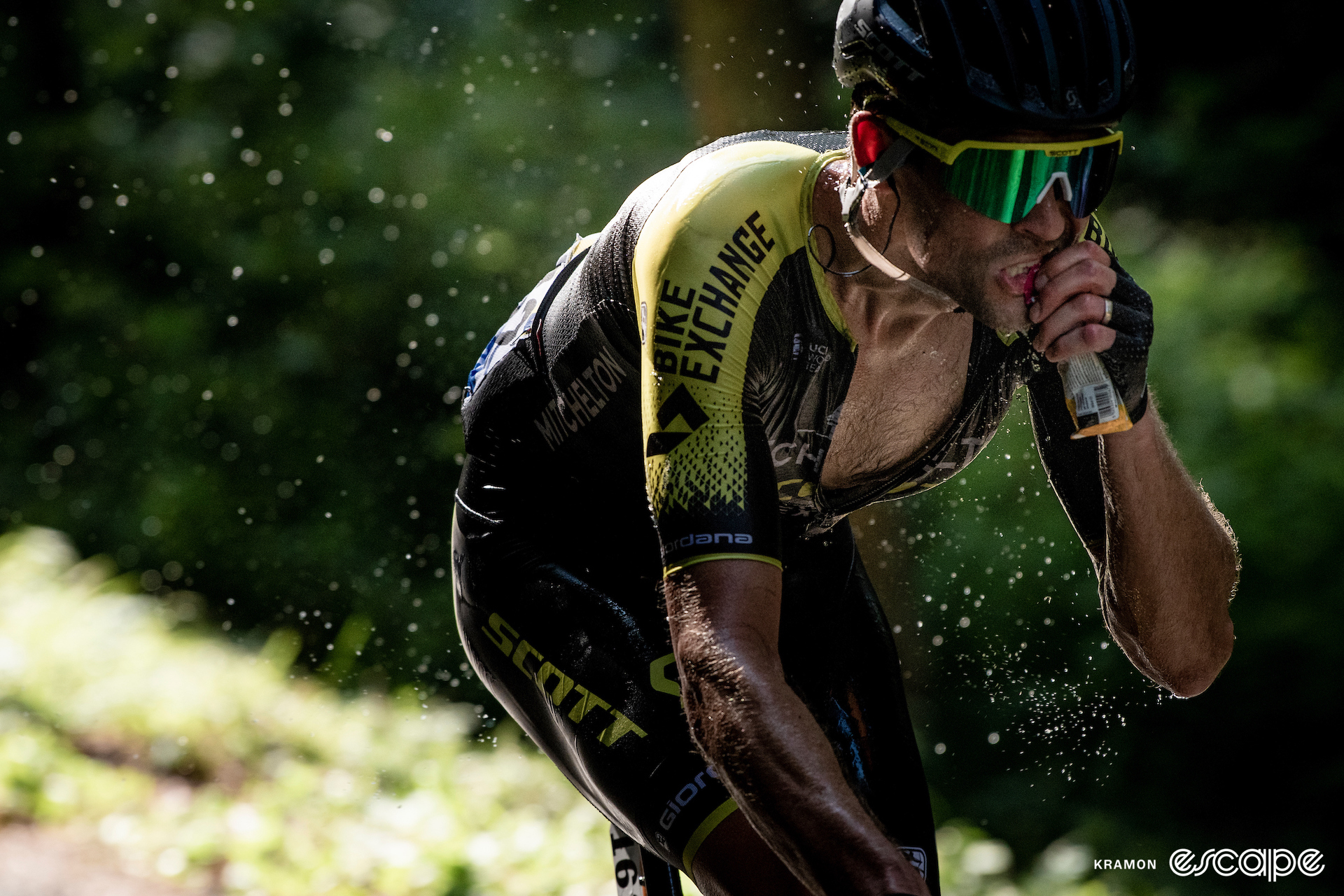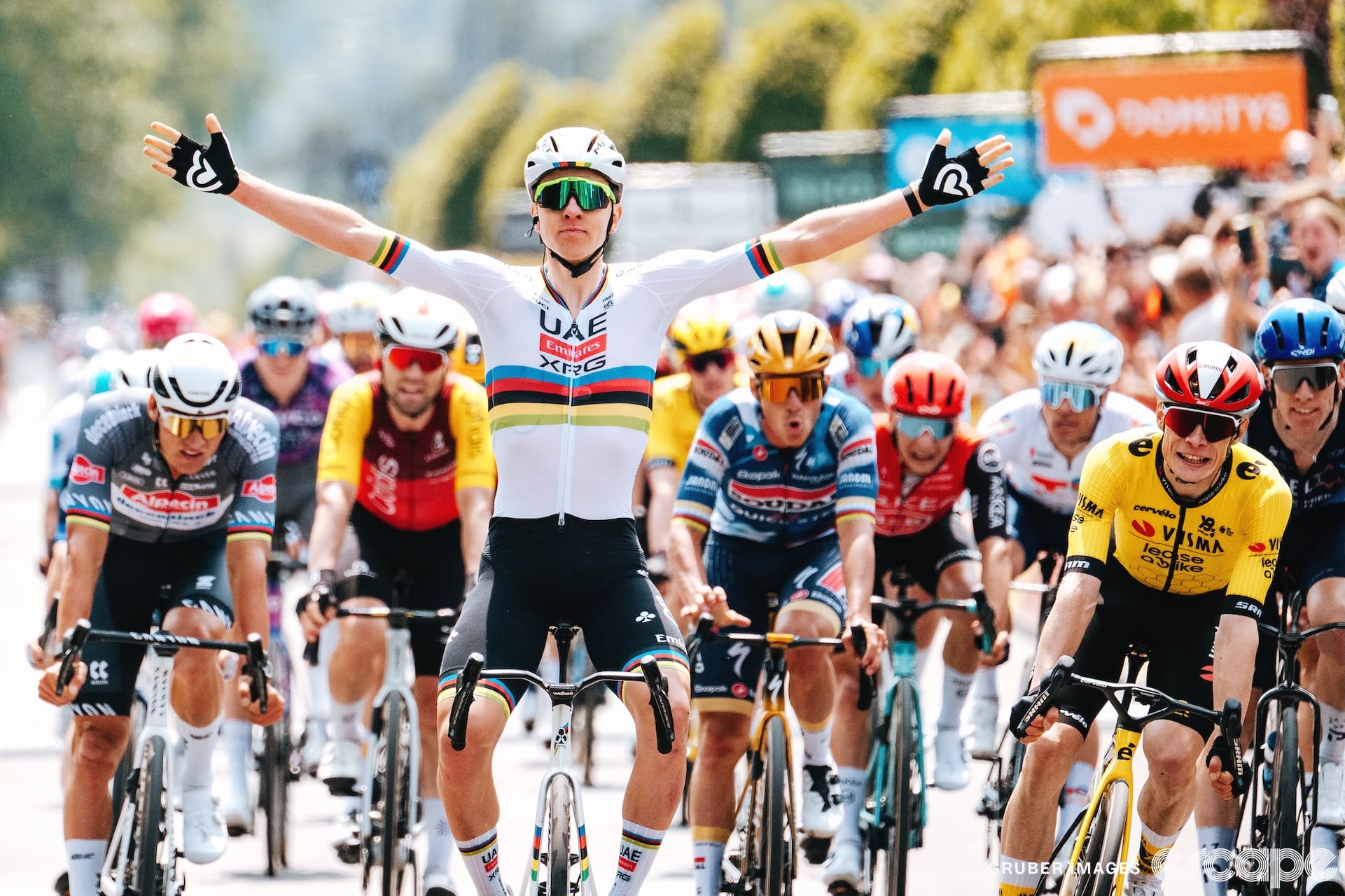It seems like everywhere you go at the moment, people are talking about “the high carb trend” in endurance sports. That’s very much the case in pro cycling, as tech editor Ronan Mc Laughlin covered in a recent episode of the Performance Process podcast.
The “Carbolution” (no I didn’t just make that up), as it’s been called, is very much being televised – and blogged, podcasted, YouTube’d, and tweeted (or whatever we’re supposed to call that now). But is that a good thing? Does it give us non-pros a distorted view of the nutrition needs for cycling? Are we missing important parts of the story? And what does it mean for our own nutrition practices on the bike?
In this piece we’ll unpack both the science and practicalities of carbs on the bike, discuss whether the much-vaunted quantities (often 100 grams per hour or more) improve performance, the important distinction between absolute and relative exercise intensity (and its relevance to the carb needs of non-pro athletes), and provide some recommendations for the average Escapee.
Follow the links below to read ahead:
- How did we get here?
- Do higher carb intakes actually work?
- The numbers game
- Why the pros are different to us
- Is a high-carb intake even healthy?
- The bottom line
How did we get here?
Before we go any further, let’s look at how we got here. Here’s a brief timeline of the key events that led to the current high-carb craze:
Early 2000s
A series of lab-based research studies, the majority from the University of Birmingham, investigate the role of different types of carbohydrates, taken individually or together, and the ability to digest and absorb these, get them into the muscles, and turn them into energy. Until this time it was believed that 60 g/hr was the maximum rate that carbs could be absorbed from the gut and utilised during exercise, so recommendations never exceeded this.
2008
The above work culminates in what many consider a “classic” research paper, describing a study comparing 90 g/hr of carbs from glucose alone vs a combination of glucose (60 g/hr) and fructose (30 g/hr). This combination of two different types of carbohydrates, that are absorbed through separate mechanisms from the gut, was termed “multiple transportable carbohydrates”.
The paper, titled “Superior endurance performance with ingestion of multiple transportable carbohydrates” shows an 8% advantage in a time trial (completing a set amount of “work” (~67 minutes) as quickly as possible), after two hours riding at 55% of their power at VO2max whilst consuming the different carb formulations.
Keep in mind this study compared 90 g/hr of glucose to 90 g/hr of glucose/fructose mixture; it was not a comparison of 60 g/hr vs 90 g/hr of carbs. But it (and studies in the years prior) did show that consuming 90 g/hr or more was possible without gut issues and could result in more exogenous carbohydrate (carbs being consumed during exercise) being turned into energy during a ride.
2008-2010
The study mentioned was undertaken by Kevin Currell (who went on to work for the English Institute of Sport) and Prof. Asker Jeukendrup, who at the time worked with the Rabobank cycling team, multiple-time Ironman triathlon world champion Chrissie Wellington, and, through a consultancy with PowerBar, Ethiopian distance running legend Haile Gebrselassie who broke the marathon world record in 2007 and 2008. It is through this work with PowerBar that the first sports nutrition products emerge specifically marketing a 2:1 glucose:fructose ratio. Several other companies quickly follow with their drink, gel, and bar formulations.
Jeukendrup, who more recently has worked with Rabobank’s reincarnation as the team now known as Visma-Lease a Bike, is the first to point out that 90 g/hr, and the 2:1 ratio, are not magical or even theoretically ideal numbers or limits, but instead represented what they considered a sensible and practical compromise between getting in more carbs and minimising the risk of gut issues.
2010-2012
Getting in 90 g/hr is still practically difficult for most athletes because the common belief is that sports drinks should contain no more than about 6-8 grams of carbs per 100 mL to maximise fluid uptake and minimise the risk of gut issues. It therefore requires a large portion of carbs to come from gels and solid foods.
Super-sized gels emerge that provided 60 g of carbs in a single packet. Some practitioners (or maybe it’s just me with National Road Series riders at the Grafton-Inverell and the Melbourne-Warrnambool?!) experiment with adding additional carbs to sports drinks, up to about 10-15 grams of carbs per 100 mL. It doesn’t cause any problems at all. Whilst the vast majority of pro riders and teams have not embraced higher carb intakes during races at this stage, there is evidence of it occurring in some sections of the peloton as early as 2010, as seen in this tweet from Iñigo San Millán (nowadays working with UAE Team Emirates).
2013
Possibly the only “dose-response” study of carb intake and performance to date is published. In what is a rare multi-center trial in sports science, 51 participants completed four out of a total 12 different trials, providing them with zero carbs and then three different intake levels between 10-120 g/hr (in 10 g increments) during two hours of riding at 95% of their second lactate threshold. They then completed a 20 km time trial on a simulated, undulating course using a CompuTrainerTM Pro (anyone remember these?) When the data was built into a model they found the best performances at 78 g/hr, with performance starting to decline again with intakes above 80 g/hr.
2015-2018
Sports drinks start providing higher carbohydrate concentrations, particularly Maurten and SiS Beta-Fuel at 16 g per 100 mL. There is a growing realisation that drink mixes didn’t need to be limited to 6-8 g of carbs per 100 mL, since the drink is usually mixing with gels, bars, etc. in the stomach to make a 20 g per 100 mL sludge down there anyway, and it’s just easier to get carbs from drinks when you’re busy racing.
2017
A study is published by Ricardo Costa and his team at Monash University in Melbourne, and is the first to show that gut training (deliberately training with high carb intakes even if not necessary for the training session itself) can increase the gut’s ability to tolerate and absorb 90 g/hr of carbs during exercise in runners who initially found this challenging.
2018
That Giro d’Italia stage. Chris Froome pulls off a daring attack on stage 19 that wins him the maglia rosa. Team boss Dave Brailsford openly discusses nutrition and particularly a high carb intake as a key contributor to the victory. Team Sky’s nutritionist at the time, James Morton, discusses on a podcast a few years later than Froome got in about 95 g/hr of carbs that day, which was the most the team had ever attempted during his time working with them.
2019-now
Teams have increasingly focused on high carb intakes, up to and sometimes exceeding 100 g/hr. Carb intakes have increased in both training and race days. This has led to changes in the food choices of riders on the bike. This is demonstrated by a recent podcast with performance chef Nicki Strobel (previously GreenEdge and Uno-X):
“I used to, in the past, make rice cakes, banana bread and stuff like that. But the way that cycling has evolved at this point, it's pretty much full gas from the start to finish. So a lot of times real food now is not an option. Everything has to be either drinks or gels, stuff like that.
"I will sometimes prepare rice cakes, granola bars or something like that for training still, but in the actual race, the amount of food that the riders are eating is minimal at this point, because they don't really have the time to eat anything other than, you know, proper sports foods.”
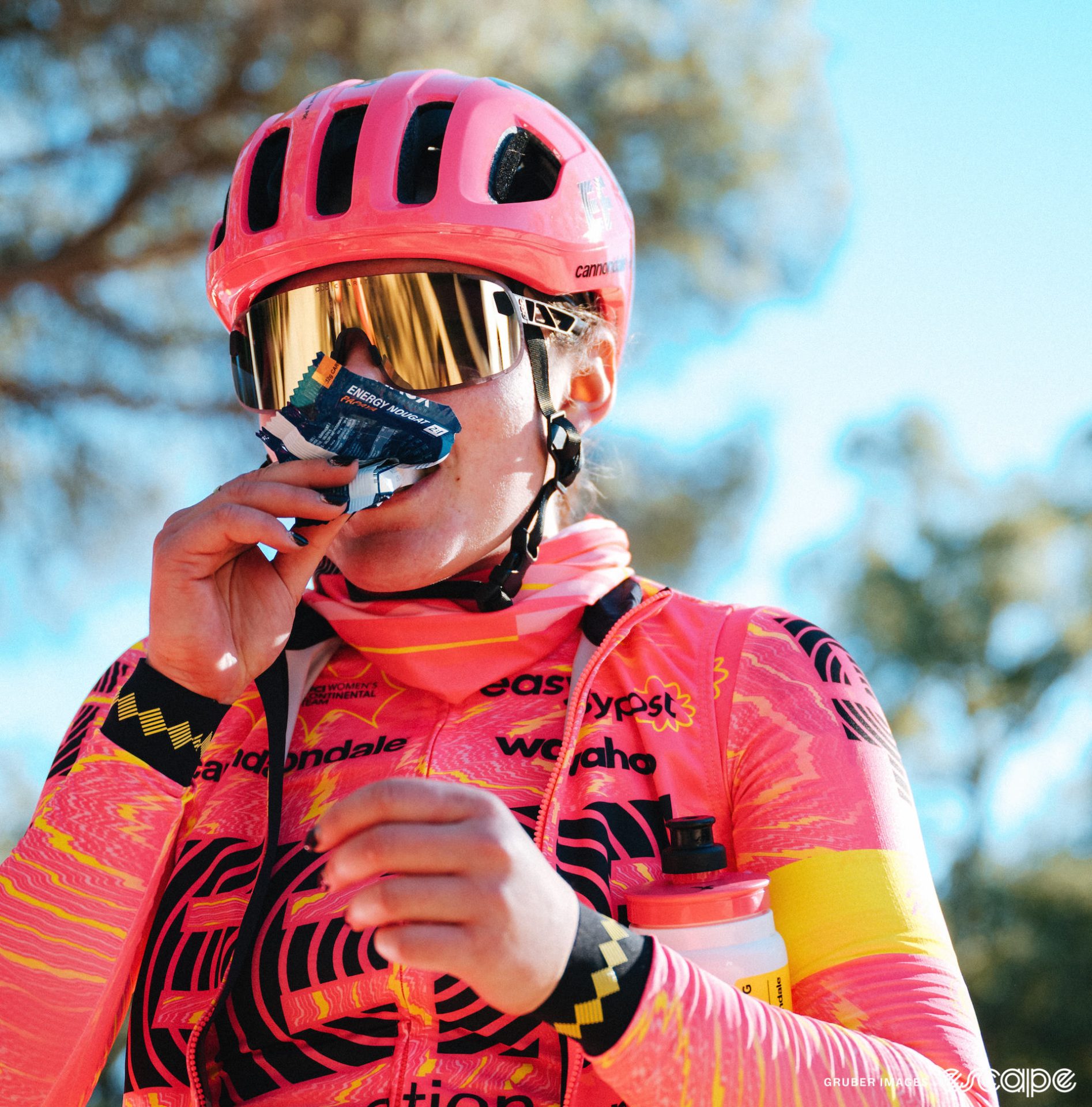
Putting it all together
The nature of racing has changed, and high carb intakes are reportedly helping to fuel this. These intakes come from a combination of research that firstly showed it was possible, from better-designed sports nutrition products that can deliver this amount of carbs more easily, and from riders doing this regularly in training so their gut is used to the high carb intakes come race day.
But is it actually working?
Despite the theoretical benefits, there’s surprisingly little research to show conclusively that more is better when it comes to carbs and performance. Early work from Jeukendrup and colleagues suggested that athletes got no further benefit beyond about 108 g/hr in terms of the ability to turn that fuel into work. And a 2022 paper from Tim Pologar (Ronan’s guest on the Performance Process podcast episode) found that going from 90 to 120 g/hr of carbs did increase the amount of those carbs turned into energy (91 vs 77 g/hr), but it did so by reducing the contribution of fat as a fuel source, rather than sparing the stored muscle glycogen.
James Morton mentioned (in the same podcast linked above) that his team at Liverpool John Moores University have compared 0, 45 and 90 g/hr of carbs with clear benefits of 90 vs 45 g/hr, but that’s a big jump and doesn’t tell us if >100 g/hr would be better still. So at this stage, there’s still really a lack of studies examining these ultra high-end carb intakes and performance.
Even if there was, the calibre of the riders studied, the exercise intensity and duration, and the conditions they commenced exercise in (fasted vs fed, how much carbs the day before, whether they were gut trained to tolerate that much carbs, etc.) would all mean the results need to be interpreted in a very specific context.
For such high carb doses to improve performance, a few things need to happen:
- The carbs need to be digested and absorbed from the gut into the blood at a rate that can keep up with how much is being shoveled in. This is where gut training is thought to help, although the research on this is still very much in its infancy.
- Once in the blood, those carbs need to get into the working muscles at a rate that allows them to be more rapidly turned into energy.
- Once in the muscle, the biochemical bits and bobs need to turn all that extra glucose into energy faster. The ability to improve this likely comes from years of training (i.e. “building the engine”), and regular exposure to carbs in the diet. Nothing diminishes this ability like a low-carb, high-fat diet, which improves the ability to turn fat into energy but does the opposite for carbs.
If any of these steps is limited, the extra carbs won’t help. The Monash gut training study measured a reduction in gut symptoms and evidence of less malabsorption (carbs that couldn’t be absorbed passing through to the large intestine), but they didn’t measure whether the carbs consumed during exercise were better able to go on to produce energy in the muscles or not.
And this is where the pros differ from the rest of us.
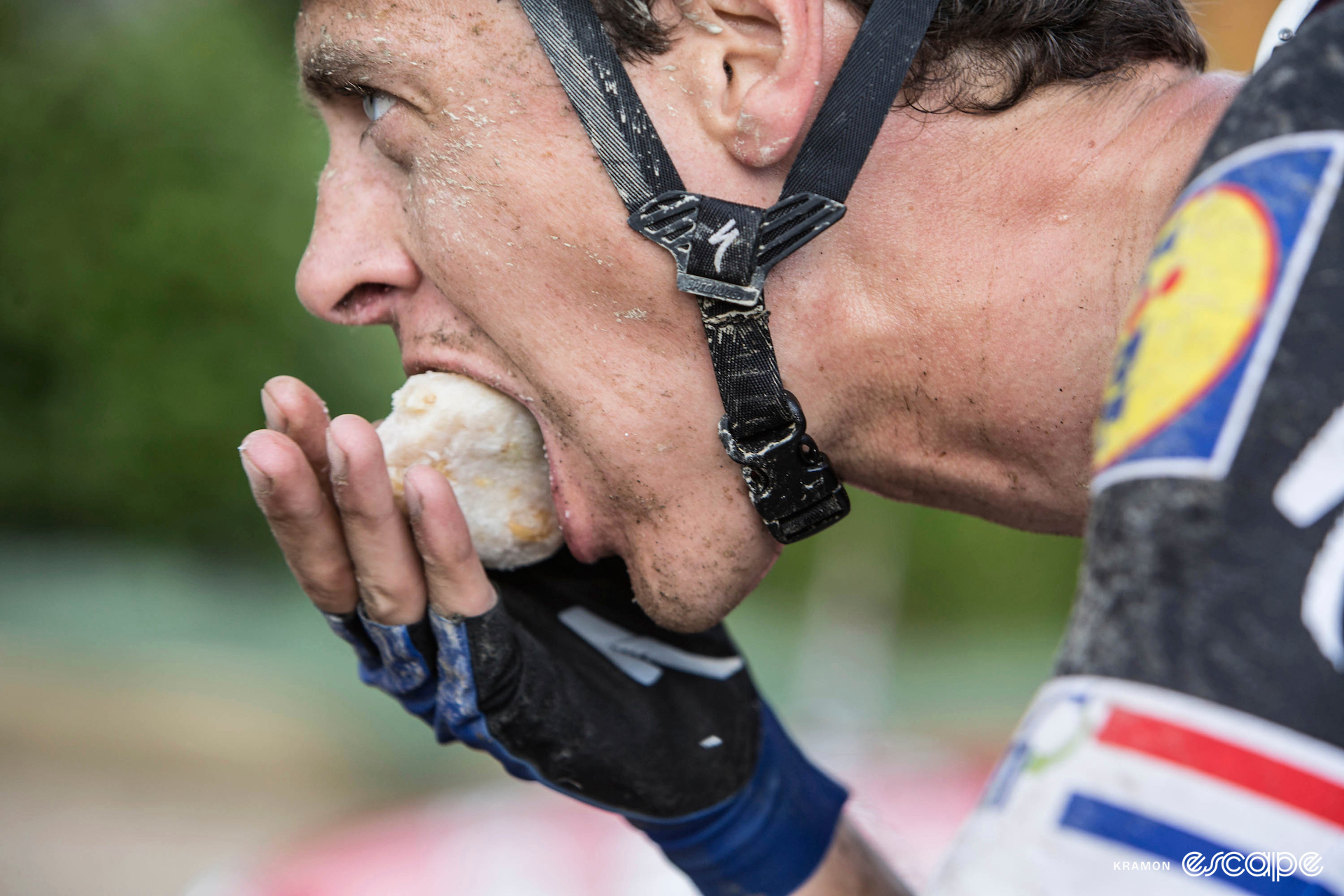
The numbers game
A simple beauty of cycling for any physiology nerd is the quantifiable nature of our sport. Physical output can be measured in watts. It’s a numbers game. So let’s play:
We can convert watts into calories expended, then quantify the requirements from carbs and fat for any given power output. For example, riding at a constant 100 W for one hour translates to 360 kJ going through the crank. That’s the Work Completed (kJ) number you see in your ride data on most training platforms. Cycling has a gross mechanical efficiency of around 20-25%, so we need to account for the other 75-80% of calories you had to burn (most of it lost as heat) to generate that 100 W of pedal power for an hour. Training platforms do this for you; it’s the calories expended number from your ride (assuming power data informed this number).
Riding at a constant 100 W would require us to expend roughly 384 calories an hour. The contribution of fat vs carbs during exercise varies a lot, but let’s use an even 50/50 split for this example. So 50% of the 384 calories need to come from carbohydrate (i.e. 192 calories). One gram of carbs yields around 4 calories, so that’s 48 g/hr of carbs required. Clearly, eating and drinking 90 g/hr or more is going to be overkill if you're riding at 100 W – you’ll be shovelling in carbs way faster than your body can use it.
If we up the effort to 200 W, this requires around 766 calories an hour, and, keeping the 50/50 split from before, 96 g/hr of carbs. That might sound like a lot, but remember not all of those carbs need to come from drinks and gels during the ride. A good portion (probably most of it when riding for less than two hours) can easily come from glycogen, the carbs already stored in your muscles, and to a smaller extent, your liver. Even a 2-3 hour ride at this power probably doesn’t need 90+ g/hr of carbs to fuel it. But 200 W average isn’t much for a male WorldTour pro. Let’s take it up another notch.
At 300 W it’s a completely different story. We’re talking 1,148 calories an hour, or 143 g/hr of carbs if maintaining that 50/50 carb/fat split. But we may not be maintaining that split. As relative intensity rises (power as a % of maximum), that split will change in favour of more carbs.
For most non-elite athletes, the ability to turn fat into energy is limited to around 0.6 g per minute, or 325 calories an hour. And this is usually at around 50-70% of our VO2max. Applying 0.6 g per minute of fat only, the remaining 823 calories per hour need to come from carbs. That’s 206 g/hr. Stored glycogen can do the heavy lifting for a while, but beyond 2-3 hours this level of total carbohydrate oxidation (the g/hr turned into energy) is likely to drop off without substantial carb intake during exercise. Carbolution.
Before the low-carb advocates pile on, the fat oxidation value above is the higher end of those reported in male athletes eating a typical mix of carbs and fat. But there are those who are exceptionally adapted to turning fat into energy, usually highly trained endurance athletes eating a strict low-carb, high-fat diet.
The highest-ever recorded values are around 1.8 g per minute of fat, or 972 calories an hour (1 gram of fat produces around 9 calories), but these numbers represent extreme outliers, in world class athletes, eating a strictly keto diet. Based on that same research carbs can still contribute 10-20% of the total, so this would bring us up to around 1,145 calories per hour, enough to produce 300 W of work, provided your FTP is north of this number (you still have to be in the sweet spot for maximum fat oxidation).
For the rest of us who aren’t world-class male athletes, fat oxidation values using this approach might be around 1-1.2 g per minute, or up to 650 calories an hour. Add in the same small carb contribution and it’s enough to sustain (with an FTP well above this mark) about 200 W. Good for long endurance rides, but not a figure that would win a lot of even high-level domestic road races.

Why the pros are different to us
As we’re busy translating carbs into watts, we need to take a minute to appreciate the difference between relative and absolute exercise intensity, and what that means for the fueling needs of different levels of cyclist.
Imagine for a minute you’re riding along a flat piece of road, side-by-side with a WorldTour pro of the same age, sex, height, and body weight/shape, and on the same equipment. But you’re still you, and they’re still a WorldTour pro. You’re riding at the same speed, so given there’s no difference in weight or drag in our hypothetical scenario, you’re putting out the same watts. In other words, you’re both working at the same absolute intensity. But it’s not the same relative intensity.
Imagine the speed chosen has you sitting right on your FTP. You’re working fairly hard, and struggling to hold a conversation. The pro on the other hand is chatting away like they’re waiting for the bus. The percentage of their max heart rate and FTP is much lower than yours despite producing the same watts. If the pro decided they wanted the same training stimulus as you and started riding at their own FTP, they would quickly disappear off down the road, putting out significantly more power than you. Now we have the same relative intensity (100% of FTP), but a very different absolute intensity (watts).
And this is why the Carbolution may not be relevant to most Escapees. You’ve probably already realised that the number of calories expended depends on absolute exercise intensity, not relative intensity. It’s the watts, pure and simple. When a WorldTour rider is working at FTP, they’re burning way more calories than you or I at our FTP. So they need more fuel than you for the same relative effort. Yes, the pros are probably also better at using fat for fuel than you, but as we’ve seen fat only gets you so far, especially at higher relative intensities where races are won or lost.
There’s currently no specific cut-offs or guidelines for the number of watts that define when 90 g/hr (or even more) of carbs is helpful. It’s not a simple number to come to either, because it depends on your ability to use fat as a fuel, your glycogen stores when starting exercise, and the length of your ride.
Prof. Jeukendrup’s suggestion has been for carb intakes of around 90 g/hr when producing over 500 calories an hour (around 130 W on the bike) for longer than three hours. For 1-3 hours, or at lower sustained power, he suggests around 60 g/hr. There’s also no specific delineation for when exceeding 90 g/hr is recommended, but the benefit would theoretically become more apparent as exercise duration exceeds four hours, and/or with increasingly higher power outputs.
Based on some theoretical data about how long stored glycogen would last before becoming depleted, and making some large generalisations about fat vs carb use during exercise, it would seem reasonable that carb intakes above 90 g/hr might be necessary for females to maintain a 150 W average (or prolonged efforts of this power within a ride) for more than four hours, or 200 W for more than three hours. For males, it might be sitting on 200 W (or significant portions of a ride at or above this) for four hours or more, or >250 W for more than three hours.
WorldTour racing will of course feature significant climbs or attacks that require much greater power outputs than this. There’s probably a rationale for more carbs to fuel those top-end efforts, making the need for such intakes occur after even shorter durations. But either way, it helps put into perspective just how much work is needed to justify such high carb intakes.

Eating for your future self
The final reason that WorldTour pros might benefit from such high carb intakes, and why the rest of us might not, is the contribution those carbs make to overall calorie intake. There’s been a lot written about the calorie expenditures of riders in Grand Tours over the years, and recent measurements of all seven riders in a WorldTour team showed an average of 7,500 calories a day expended during the 2019 men’s Vuelta a España using the gold-standard, doubly-labelled water technique. That’s a lot of calories to eat, on and off the bike.
And so perhaps an additional rationale for 100 g/hr or more in the WorldTour is not just about fueling performance in the moment, but ensuring riders don’t go into a mammoth calorie deficit throughout a stage race, that could result in reduced performance and increased risk of illness.
Is this much carbs even healthy?
There’s no shortage of keyboard warriors (they’re probably already down in the comments as you read this), writing sarcastic comments like “nice article – follow this if you want to get diabetes”, or “the golden formula for tooth decay”. These are legitimate concerns.
Firstly, on the metabolic side of things, the evidence suggests that it’s an excessive carb intake that’s a problem. And by excessive I don’t mean lots of carbs, I mean more than the body needs to do what you’re asking it to. As we’ve seen, WorldTour riders need a lot of calories, and a large chunk of that will come from carbs. For most of the season they’re at far greater risk of health consequences from under-fueling than over-fueling.
But for the rest of us it’s a completely different story. As shown above, most Escapees don’t need 100+ g/hr on the bike, or only require it a few times a year at key races, gran fondos and the like. The rest of the year, such intakes are not only unnecessary, but they’re likely to increase your expenses, your waistline, and your risk of chronic disease.
As for our dental health, this is definitely a concern, especially since most sports nutrition products are both quite acidic (part of making them taste good) and quite sticky (getting stuck in the cracks and crevices or your teeth). Both of these aren’t great for your teeth.
On the acidity side, increasing numbers of products are coming out at a lower level of acidity which is helpful, and rinsing out your mouth with plain water may help reduce the amount of stuff that gets stuck in your mouth for hours. Don’t brush your teeth immediately after though – the acidity will soften your tooth enamel for about an hour afterwards, and brushing at this time can actually remove some of this protective surface.
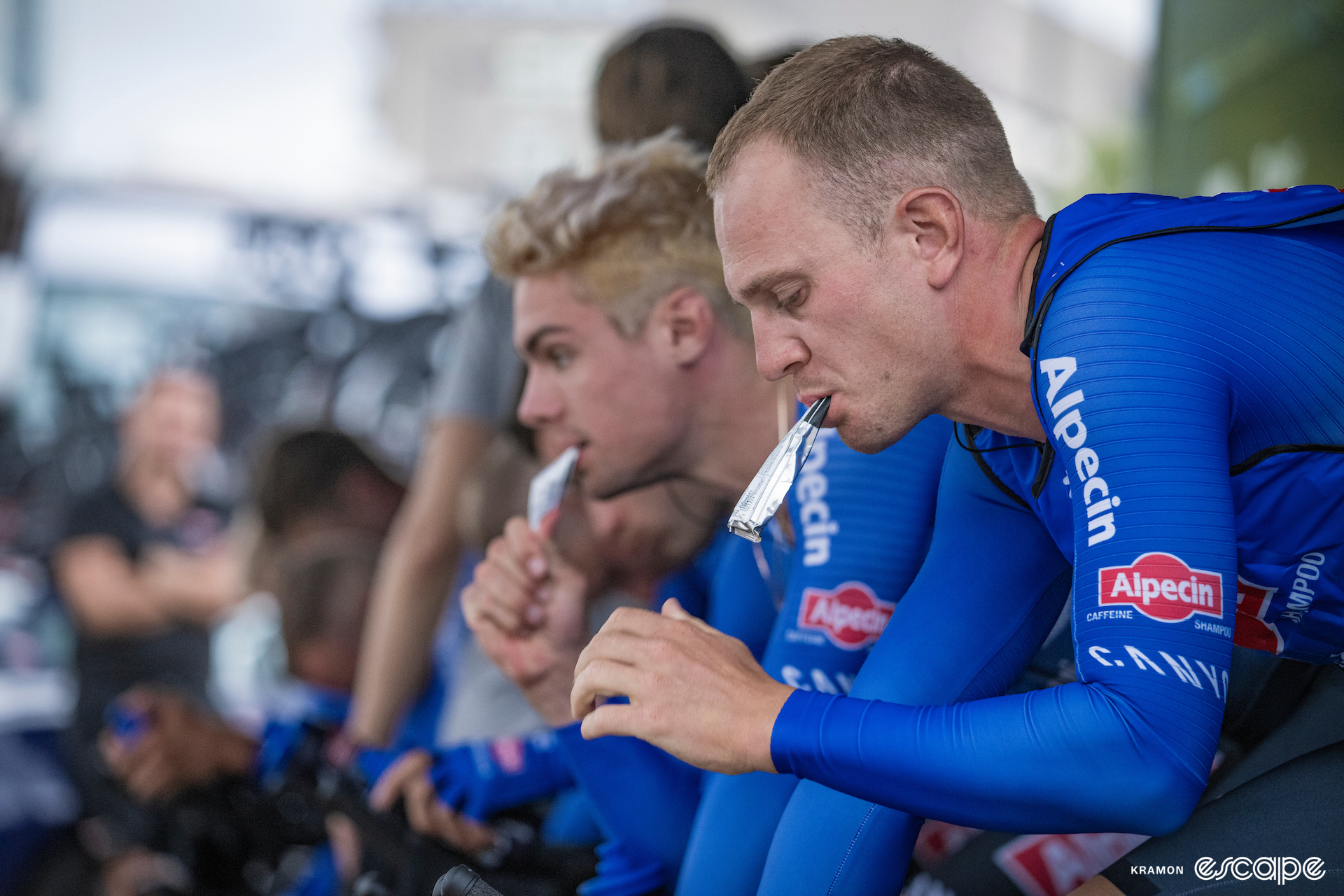
The bottom line
Whilst we don’t have all the scientific answers yet, it’s clear that fueling the needs of male (and sometimes female) pro cyclists often requires carb intakes of at least 90 g/hr. From what data we do have, there may be diminishing returns once carb intakes exceed this level, either because all those carbs aren’t getting absorbed from the gut, or because the muscles can’t turn the extra carbs into energy fast enough. Both factors are theoretically trainable (we don’t have research on WorldTour level riders) but may also have ceilings that we’ll start butting up against.
Future research will no doubt answer these questions, and ultimately needs to demonstrate that 100+ grams of carbs an hour improves the thing that actually matters – performance. It’s clear though that those working in the WorldTour feel there’s a benefit to be gained, and this approach has increasingly taken hold, aided by newer, more practical sports nutrition products, better-trained guts, and targeted support to feed riders more out on the road.
For Escapees reading this, hopefully you’ve gained an appreciation that just because the Carbolution might be helping pro riders, doesn’t mean it will for you. Cycling is a numbers game, and if your numbers don’t add up then you’ll be over-feeding carbs for no performance benefit, with an increased risk of gut issues, a costly energy gel tab, and potential increased risk of longer-term health consequences.
If you feel you can and should be producing these sustained power numbers, but don’t currently take this much carbs on the bike, realise that it’s not enough to just go out and double your carb intake tomorrow. You need to build your gut’s ability to digest and absorb these high carb intakes over a few weeks. Practically speaking, it’s also going to mean a lot more drinks and gels, and a lot less real food.
No one said the Carbolution would be easy.
About the author
Alan is an Accredited Sports Dietitian, researcher, podcaster, and practitioner in the field of endurance sports nutrition. He works with endurance athletes of all levels, from complete beginners to professional and Olympic athletes, and has previously worked with UCI Continental teams, and athletes from Triathlon Australia’s High-Performance Program in the lead up to the Tokyo Olympics and Paralympics.
Alan consults through his own business Next Level Nutrition, training-based nutrition coaching app Fuelin, and is the founder and co-host of the Fueling Endurance podcast. Alan started contributing to The Other Place back in 2011, and was a proud founding member of Escape Collective.
Did we do a good job with this story?

